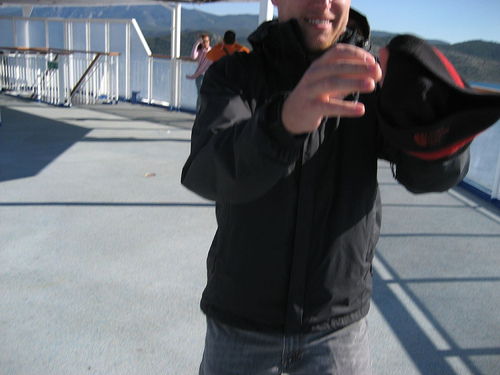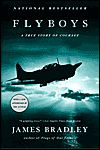
Iwo Jima
On Feb. 19, 1945, more than 110,000 Americans and 880 ships began their assault on a small volcanic island in the Pacific, in the climactic battle of the last year of World War II. For the next 36 days Iwo Jima would become the most populous seven-and-a-half square miles on the planet, as United States Marines and Japanese soldiers fought a battle that would test American resolve even more than D-Day or the Battle of the Bulge had, and that still symbolizes a free society's willingness to make the sacrifice necessary to prevail over evil -- a sacrifice as relevant today as it was 60 years ago.
The attack on Iwo Jima capped a two year island-hopping campaign which was as controversial with politicians and the press as any Rumsfeld strategy. Each amphibious assault had been bloodier than the last: at Tarawa, where 3,000 ill-prepared Marines fell taking an island of just three square miles; at Saipan, where Army troops performed so poorly two of their generals had to be fired; and Peleliu, where it took 10 weeks of fighting in 115 degree heat to root out the last Japanese defenders, at the cost of 6,000 soldiers and Marines.
Iwo Jima would be the first island of the Japanese homeland to be attacked. The Japanese had put in miles of tunnels and bunkers, with 361 artillery pieces, 65 heavy mortars, 33 large naval guns, and 21,000 defenders determined to fight to the death. Their motto was, "kill 10 of the enemy before dying." American commanders expected 40% casualties on the first assault. "We have taken such losses before," remarked the Marine Corps Lt. Gen. Holland M. Smith, "and if we have to, we can do it again."
Even before the attack, the Navy's bombardment of Iwo Jima cost more ships and men than it lost on D-Day, without making a significant dent in the Japanese defenses. Then, beginning at 9 a.m. on the 19th, Marines loaded down with 70 to 100 pounds of equipment each hit the beach, and immediately sank into the thick volcanic ash. They found themselves on a barren moonscape stripped of any cover or vegetation, where Japanese artillery could pound them with unrelenting fury. Scores of wounded Marines helplessly waiting to be evacuated off the beach were killed "with the greatest possible violence," as veteran war reporter Robert Sherrod put it. Shells tore bodies in half and scattered arms and legs in all directions, while so much underground steam rose from the churned up soil the survivors broke up C-ration crates to sit on in order to keep from being scalded. Some 2,300 Marines were killed or wounded in the first 18 hours. It was, Sherrod said, "a nightmare in hell."
And overlooking it all, rising 556 feet above the carnage, stood Mount Suribachi, where the Japanese could direct their fire along the entire beach. Taking Suribachi became the key to victory. It took four days of bloody fighting to reach the summit, and when Marines did, they planted an American flag. When it was replaced with a larger one, photographer Joe Rosenthal recorded the scene -- the most famous photograph of World War II and the most enduring symbol of a modern democracy at war.
Yet, in the end, a symbol of what? Certainly not victory. The capture of Suribachi only marked the beginning of the battle for Iwo Jima, which dragged on for another month and cost nearly 26,000 men -- all for an island whose future as a major air base never materialized. Forty men were in the platoon which raised the flag on Suribachi. Only four would survive the battle unhurt. Their company, E Company, Second Battalion, 28th Regiment, Fifth Marine Division, would suffer 75% casualties. Of the seven officers who led it into battle, only one was left when it was over.
But the Marines pushed on. Over the next agonizing weeks, they took the rest of the island yard by yard, bunker by bunker, cave by cave. They fought through places with names like "Bloody Gorge" and "The Meat Grinder." They learned to take no prisoners in fighting a skilled and fanatical enemy who gave no quarter and expected none. Twenty out of every 21 Japanese defenders would die where they stood. One in three Marines on Iwo Jima would either be killed or wounded, including 19 of 24 battalion commanders. Twenty-seven Marines and naval medical corpsmen would win Medals of Honor -- more than in any other battle in history -- and 13 of them posthumously. As Admiral Chester W. Nimitz, commander in chief of the U.S. Pacific Command, said, "Among the Americans who served on Iwo Island, uncommon valor was a common virtue."
* * *
Yet even this valor and sacrifice is not the full story of what Iwo Jima means, or what Rosenthal's immortal photograph truly symbolizes. The lesson of Iwo Jima is in fact an ancient one, going back to Machiavelli: that sometimes free societies must be as tough and unrelenting as their enemies. Totalitarians test their opponents by generating extreme conditions of brutality and violence; in those conditions -- in the streets and beheadings of Fallujah or on the beach and in the bunkers of Iwo Jima -- they believe weak democratic nerves will crack. This in turn demonstrates their moral superiority: that by giving up their own decency and humanity they have become stronger than those who have not.
Free societies can afford only one response. There were no complicated legal issues or questions of "moral equivalence" on Iwo Jima: It was kill or be killed. That remains the nature of war even for democratic societies. The real question is, who outlasts whom. In 1945 on Iwo Jima, it was the Americans, as the monument at Arlington Cemetery, based on Rosenthal's photograph, proudly attests. In the jungles of Vietnam and Cambodia in the 1970s, it was the totalitarians -- with terrible consequences.
Today, some in this country think the totalitarians may still win in Iraq and elsewhere. A few even hope so. Only one thing is certain: As long as Americans cherish the memory of those who served at Iwo Jima, and grasp the crucial lesson they offer all free societies, the totalitarians will never win.
By ARTHUR HERMAN
February 18, 2005; Page A10 Wall St. Journal
Mr. Herman, a historian, is the author, most recently, of To Rule the Waves: How the British Navy Shaped the Modern World
















No comments:
Post a Comment